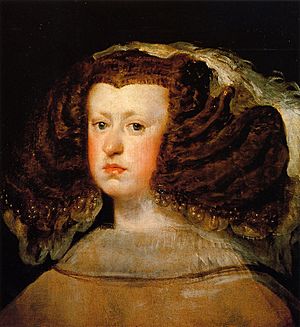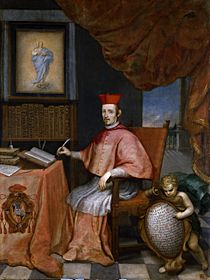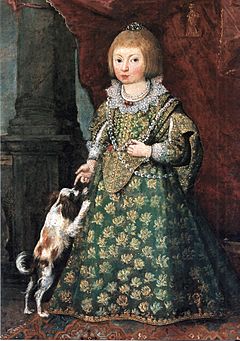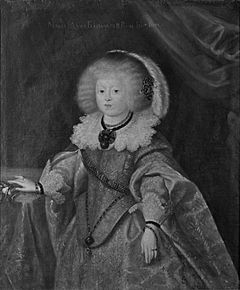Mariana of Austria facts for kids
Quick facts for kids Mariana of Austria |
|||||
|---|---|---|---|---|---|

Portrait of Mariana of Austria by Diego Velázquez, 1652–53
|
|||||
| Queen consort of Spain | |||||
| Tenure | 7 October 1649 – 17 September 1665 | ||||
| Queen regent of Spain | |||||
| Regency | 17 September 1665 – 6 November 1675 | ||||
| Monarch | Charles II | ||||
| Born | 24 December 1634 Wiener Neustadt, Archduchy of Austria, Holy Roman Empire |
||||
| Died | 16 May 1696 (aged 61) Uceda Palace, Madrid, Spain |
||||
| Burial | El Escorial | ||||
| Spouse | |||||
| Issue | |||||
|
|||||
| House | Habsburg | ||||
| Father | Ferdinand III, Holy Roman Emperor | ||||
| Mother | Maria Anna of Spain | ||||
| Religion | Roman Catholic | ||||
| Signature |  |
||||
Mariana or Maria Anna of Austria (born December 24, 1634 – died May 16, 1696) was the Queen of Spain. She became queen in 1649 when she married her uncle, Philip IV of Spain. After Philip's death in 1665, she became the regent for their young son, Charles II of Spain.
A regent is someone who rules a country when the king or queen is too young or unable to rule. Mariana was a very important person in Spain until she passed away in 1696. Her time as regent was challenging. Spain was facing many problems after 1648, including a decline in its power and economic issues.
Her son, Charles II, had poor health and could not have children. This led to other European countries trying to gain power in Spain. This struggle eventually caused the War of the Spanish Succession from 1701 to 1714. The Mariana Islands and the Mariana Trench in the Pacific Ocean are named after her.
Contents
Her Early Life
Maria Anna was born on December 24, 1634, in Wiener Neustadt. She was the second child of Maria Anna of Spain and Ferdinand III, Holy Roman Emperor. Her father became the Holy Roman Emperor in 1637.
Her parents had six children, but only Maria Anna and two of her brothers lived to be adults. Her brothers were Ferdinand (who died in 1654) and Leopold (who later became emperor in 1658).
Becoming Queen of Spain
The Habsburg family, which Mariana belonged to, often married relatives. This was done to keep their lands and wealth within the family. In 1646, Maria Anna was supposed to marry her cousin, Balthasar Charles, Prince of Asturias. He was the heir to the Spanish throne.
However, Balthasar Charles died three months later. This left Maria Anna without a husband and her uncle, Philip IV of Spain, without an heir. So, on October 7, 1649, the 44-year-old King Philip married his 14-year-old niece. The wedding took place in Navalcarnero, near Madrid. From then on, she was known by her Spanish name, Mariana.
At that time, women were not usually involved in politics. So, Mariana focused on religion and her education. These were seen as suitable roles for women.
Mariana and Philip had five children, but only two lived to adulthood. Their oldest daughter, Margaret Theresa (1651–1673), married her uncle, Leopold I, Holy Roman Emperor, in 1666. Their second daughter, Maria Ambrosia, lived for only fifteen days. Two sons, Philip Prospero (1657–1661) and Ferdinand Thomas (1658–1659), also died very young.
On November 6, 1661, Mariana gave birth to her last child, Charles II of Spain. Charles was later called "The Bewitched" because of his health problems. He had a very pronounced "Habsburg jaw," which made it hard for him to speak and eat. He did not learn to walk until he was eight years old.
Some people thought his health issues were due to "sorcery." Others believed his problems were made to seem worse by those who wanted to keep political power. Charles suffered from poor health throughout his life. His inability to have children led to a power struggle among European leaders. They all wanted to control who would rule Spain next.
Ruling as Regent

First Regency: 1665–1677
Charles was only three years old when his father, King Philip, died on September 17, 1665. Mariana was chosen to be the regent. She would rule until Charles turned 14, which was considered adulthood back then. She had a group of advisors called the Regency Council.
Mariana chose a "favourite" advisor, a system used by her husband and other European rulers. Her first favourite was Juan Everardo Nithard, an Austrian Jesuit priest. He had come with her from Vienna. Because Philip's will said foreigners could not be on the Regency Council, Nithard had to become a Spanish citizen. This caused some people to be upset.
Mariana herself was a foreigner. Her main advisors, Nithard and later Fernando de Valenzuela, were also seen as outsiders. Mariana used these advisors to keep her power. She also had female advisors, like Mariana Engracia Álvarez de Toledo Portugal y Alfonso-Pimentel.
Because her son Charles was often sick and had no heir, there was a constant power struggle. One group supported Mariana's "Austrian" side. Another group, led by Charles's half-brother John of Austria the Younger, supported a "French" side. This struggle lasted until John's death in 1679.
Spain was also divided into two main parts: Castile and Aragon. These parts had different political systems. This made it very hard to make changes or raise taxes. As a result, Spain's government was always short on money. The country declared bankruptcy several times.
Mariana faced huge challenges. Spain was tired from almost a century of wars. Her rule also happened during a period of cold weather called the Little Ice Age. This led to crop failures across Europe. Many people starved during this time.

The new government also had many economic and political problems. The war with Portugal, called the Portuguese Restoration War, was the most urgent. Then, in May 1667, France invaded Spanish lands in the Netherlands and Franche-Comté. To save money, Spain signed peace treaties in 1668 with France and Portugal. These treaties ended the wars.
Peace stopped Spain from spending so much money. The treaty with France also made France give back most of the lands it had taken. However, the Spanish army saw these treaties as a humiliation. In 1668, a captain was executed for planning to murder Nithard.
This power struggle led to Nithard being sent away in February 1669. He became an ambassador in Rome. Valenzuela became Mariana's new advisor. In 1672, Spain got involved in the Franco-Dutch War. Valenzuela was dismissed when Charles became an adult in 1675. However, the fight for power continued. Mariana started her regency again in 1677 because Charles was still too ill. Valenzuela was brought back, but John of Austria the Younger finally took control later that year.
Second Regency: 1679–1696
John of Austria the Younger died in September 1679. Mariana became regent once more. One of John's last actions was to arrange Charles's marriage to 17-year-old Marie Louise of Orléans. They married in November 1679.
Marie Louise died in February 1689 without having any children. People at the time often thought mysterious deaths were caused by poison. However, experts today believe she likely died from appendicitis.
Charles needed a new wife to have an heir. His next wife was Maria Anna of Neuburg. Her family was known for having many children, which made them popular for royal marriages. Maria Anna's sisters also married important rulers.
Charles still did not have children. As his health got worse, the fight over who would inherit the throne became very intense. The leader of the pro-French group was Fernández de Portocarrero, a powerful cardinal.
In 1690, Spain joined the Grand Alliance in the Nine Years' War against France. This was influenced by Mariana's "Austrian" supporters. Spain declared bankruptcy again in 1692. By 1696, France had taken over most of Catalonia. Mariana kept her power with help from German soldiers. These soldiers were led by Maria Anna's brother, Charles Philip. Many of them were sent away after Mariana's death.
Mariana died on May 16, 1696, at the Uceda Palace in Madrid. She was sixty-one years old.
Her Children
- As Queen of Spain from 1649 to 1665, Mariana had five children:
- Margaret Theresa (born July 12, 1651 – died March 12, 1673). She married Leopold I, Holy Roman Emperor in 1666.
- Maria Ambrosia de la Concepción (born December 7, 1655 – died December 21, 1655). She died as a baby.
- Philip Prospero, Prince of Asturias (born November 28, 1657 – died November 1, 1661). He died as a young child.
- Ferdinand Thomas, Infante of Spain (born December 21, 1658 – died October 23, 1659). He also died as a baby.
- Charles II of Spain (born November 6, 1661 – died November 1, 1700).
Her Legacy
In 1668, Mariana approved a mission by Jesuit priests to a group of islands in the Pacific Ocean. The Spanish had called these islands the Ladrones. They were renamed the Mariana Islands in her honor.
The famous Portrait of Mariana of Austria was painted by Diego Velázquez. King Philip asked him to paint it. This is the only full-length painting of her that we know of. The original painting is in the Prado Museum in Madrid. A copy was sent to her father, Ferdinand, and is now in a museum in Vienna. Other portraits of her were also made. She also appears in Velázquez's famous painting, Las Meninas, which features her daughter Margaret Theresa.
Images for kids
See also
 In Spanish: Mariana de Austria para niños
In Spanish: Mariana de Austria para niños






